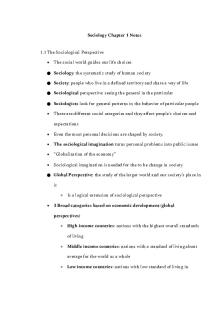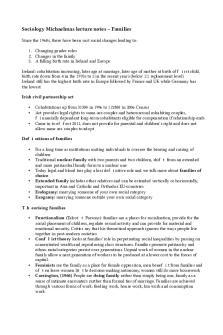Sociology of family wk 1 notes PDF

| Title | Sociology of family wk 1 notes |
|---|---|
| Author | Angeline Yeo |
| Course | Sociology of Family |
| Institution | National University of Singapore |
| Pages | 4 |
| File Size | 98.1 KB |
| File Type | |
| Total Downloads | 25 |
| Total Views | 141 |
Summary
Download Sociology of family wk 1 notes PDF
Description
WEEK 1: Introduction to Family Sociology What is a family? -
Describing intergenerational/blood relations, emotional attachments, ownership of property/business, shared knowledge and practices, moral values etc. Different family structures Couple Nuclear parents and their dependent children Stem parents and only one married child, may or may not have grandchildren Joint several married siblings living together, may or may not with parents and grandchildren
Family as a social construct - Definition of family a group of two or more people related by blood, marriage, or adoption and residing together Living arrangement the way people organizes how and where they live Household a group of two or more persons living together in the same house and sharing common food or other arrangements for essential living - Definition of family changes from context to context Family could be whatever an individual says it is Family is not a natural feature of human life Family does not have a reality separate from people’s definition of it - The meaning attached to family is a matter of collective definition and human agreement - Social consequences Respect, recognition, rights, benefits, and access to programmes and services Family as a cultural symbol Who is seen as deserving of rights and privileges for families? - “The family” heterosexual married households with children whereby women and men assume traditional gender roles - “Lesser families” less social rewards Why is family important? - Social institution established and organised systems of social behaviour with a particular and recognised purpose Shaped socially and changes the society marriage, religion, education, government, economy etc. - Families serve central social functions private and public Childbearing and socialising of children o Public reproduction and socialisation of members of the society Adult intimate relationships o Public regulated and stabilised Lifelong economic support and cooperation stable support that is predictable o Public production at the society level Continuity of relationships along the life course o Public care and support throughout the life course Sociology of family - Wright Mills sociological imagination of the relationship between individuals and the society they live in, social structure - Sociological imagination of families social institution of family and social structure
Powell (2017) Changing counts, counting change: toward a more inclusive definition of family - Standard North American Family (Smith 1993) strongly privileges heterosexual married households and, in particular, those that include children and those in which women and men assume traditional gender roles Portrayed as “the family” and the gold standard by which other family arrangements are evaluated “lesser” families or not as families at all - Survey results more disagreement in views regarding unmarried heterosexual and especially same-sex couples - Typologies of family definitions Exclusionists most restrictive definition of family, heterosexual married households particularly those that include children Inclusionists broad, all-encompassing definition of family, does not distinguish between households with and without children, between married and unmarried households and between same-sex and heterosexual households Moderates include some same-sex living arrangements in their definition of family, primed to become even more inclusive in the future - Slow change of public opinion extremely difficult to change the norms and culture because of the social functions of family Exclusionists vs inclusionists - Exclusionists Marriage is fundamental Emphasis on heterosexuality and strong censuring of homosexuality Disapprove often couched in religious terms (marriage as ordained by God) Children are important to the definition of family framed in terms of blood ties Definitions of family rely on law, religion and the structure of the relationship - Inclusionists Definitions focus on function if a living arrangement acts like a family and feels like a family, it is a family (how people treat each other) Whether a living arrangement counted as a family should be determined by those in the living arrangement (individual thinking) Moderates: an evolving group - Moderates emphasized marriage and children for what they signified quality of relationship, commitment, responsibility, and a guarantee - Moderates unlike inclusionists need confirmation of commitment instead of assuming the presence of commitment in a relationship unless otherwise disconfirmed often in the form of legal status of parenthood, and in time together before according family status to a household - Absence of marital rights to same-sex couples has provided an obstacle to their being seen as family need to use test of time having lived together to be seen as family - Time together, not unlike marriage and children, is a persuasive marker of commitment that can push many moderates toward a more inclusive vision of family - Seen as evolving or in transition as they struggle with issues regarding family Differing views regarding same-sex marriage - Stalled gender revolution Stacey (2011) Unhitched: Love, Marriage and family values from West Hollywood to Western China Introduction - Challenging the singular view of a proper happy family/”normal family” as married, monogamous, heterosexual pair and their progeny - Marriage exposed the fallacies of the one-size-fits-all vision of happy families that undergirds and distorts public family policy - Debunking the marriage promotion movement
That marriage is a universal and necessary institution That the ideal family structure for raising children is a married man and woman and their biological or adopted children That children generally, and boys particularly, need both a father and a mother to turn out well - Different sorts of families foster different patterns of happiness and unhappiness for their members, and social political and economic conditions buttress and batter them Domesticity is rarely an aphrodisiac - Societies depend on families to feed and form children and to sustain and restrain adults Human societies contend with irreconcilable tensions between the domains of eros and domesticity (from Freud’s view on the human condition and the competing demands of id and superego) - Families serving as culture’s counterpart to the ego To negotiate inescapable conflicts between romantic/sexual desires and timeless human and social needs for durable, dependable, intimate relationships and care Nuclear family reciprocal romantic love inspires one man and one woman to exchange vows to forsake all others o Actually the cultural exception rather than the rule as different societies devise different families to confront the quandary - Romantic love and erotic attractions rarely enter into the calculus of traditional marital matchmaking Most family systems try to manage the conflict between desire and domesticity by sacrificing the yearnings of the former to the demands of the latter, especially when the former belongs to women Patriarchal marriage systems rigorously restrict, and at times excise, women’s sexual and romantic cravings in order to secure the fruits of their procreative and domestic labours - Sturdy remnants of many of these traditional kinship regimes, some with boggling permutations of love, sex, marriage, and parenthood, survive in our contemporary world. More marriage systems have been polygamous than monogamous (almost always polygynous — one man with multiple wives — and very rarely polyandrous — one woman with multiple husbands), and arranged marriage systems far outnumber free love matches. Along with a range of traditional marital/sexual/parental practices - Differing views in different traditional societies Versions of gender and sexuality extending beyond the mainstream norm many alien family practices Inventing new forms of intimacy and kinship or imposing ‘alternative’ family lives on people colonised/enslaved Examples of policy/rules created to either create more collective and fluid forms of parenting and kinship, or to prevent certain types of intimacy like biracial unions and families As time passed, more novel and exotic forms of intimacy were invented as alternatives to monogamous married family life - Expectations of love, marriage, parenthood and kinship drawn from prevailing Western theories about family, intimacy, and modernity - 2 bodies of theory Diverse theirs of modernisation predicted that urbanisation, economic development and the global spread of media, markets, and migration would diffuse Western family life throughout the developing world o Irrepressible, global triumph of democratic, voluntary, love-match, companionate marriages and egalitarian gender norms over traditional patriarchal marriage regimes Theorists of post-modern transformations of intimacy and critics of these changes have faced off over contemporary prospects that eros will utterly vanquish domesticity
o o
o
Economic and social conditions of late modernity enable a liberated practice of intimacy (Giddens pure relationship) He reasoned that with sexuality “severed from its age-old integration with reproduction, kinship and the generations,” equals were becoming free to pursue intimacy purely “for its own sake,” and so intimate relationships would endure only so long as they “deliver enough satisfactions for each individual to stay within it.” Optimists and pessimists generally share an expectation that globalisation will erode traditional family forms...
Similar Free PDFs

Sociology of family wk 1 notes
- 4 Pages

Sociology Notes (Family)
- 6 Pages

Sociology-family - Lecture notes 1-8
- 39 Pages

Sociology notes chp 1
- 12 Pages

Sociology Notes Chp 1
- 11 Pages

Family-Law-1 - notes
- 56 Pages

Sociology Chapter 1 Notes
- 8 Pages

Family law 1 ( notes )
- 75 Pages

Sociology Of Culture Class Notes
- 72 Pages

Wk 1 Samsung - Lecture notes 1
- 17 Pages

Sociology 1101 notes section 1
- 2 Pages

ACCG2002 Wk 1 - Lecture notes 1
- 3 Pages

Sociology 8 - Lecture notes 1
- 3 Pages
Popular Institutions
- Tinajero National High School - Annex
- Politeknik Caltex Riau
- Yokohama City University
- SGT University
- University of Al-Qadisiyah
- Divine Word College of Vigan
- Techniek College Rotterdam
- Universidade de Santiago
- Universiti Teknologi MARA Cawangan Johor Kampus Pasir Gudang
- Poltekkes Kemenkes Yogyakarta
- Baguio City National High School
- Colegio san marcos
- preparatoria uno
- Centro de Bachillerato Tecnológico Industrial y de Servicios No. 107
- Dalian Maritime University
- Quang Trung Secondary School
- Colegio Tecnológico en Informática
- Corporación Regional de Educación Superior
- Grupo CEDVA
- Dar Al Uloom University
- Centro de Estudios Preuniversitarios de la Universidad Nacional de Ingeniería
- 上智大学
- Aakash International School, Nuna Majara
- San Felipe Neri Catholic School
- Kang Chiao International School - New Taipei City
- Misamis Occidental National High School
- Institución Educativa Escuela Normal Juan Ladrilleros
- Kolehiyo ng Pantukan
- Batanes State College
- Instituto Continental
- Sekolah Menengah Kejuruan Kesehatan Kaltara (Tarakan)
- Colegio de La Inmaculada Concepcion - Cebu


